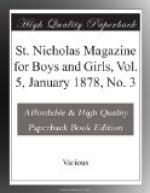I next visited the chapel of Islip, built by the old Abbot of Islip, who dedicated it to St. John the Baptist. One very interesting monument there was to the memory of General Wolfe, who fell, you remember, at the battle of Quebec. His monument is a very beautiful piece of art. It represents him falling into the arms of one of his own soldiers, who is pointing to Glory, which comes in the shape of an angel from the clouds, holding a wreath with which to crown the hero. A Highland sergeant looks sorrowfully on the dying warrior, while two lions sleep at his feet. The inscription reads as follows: “To the memory of James Wolfe, Major-General and Commander-in-Chief of the British land forces on an expedition against Quebec, who, after surmounting, by ability and valor, all obstacles of art and nature, was slain in the moment of victory, on the 13th of September, 1759, the King and Parliament of Great Britain dedicate this monument.”
I now walked on to the north transept, and the first monument I noticed was one erected to Sir Robert Peel, the great orator and statesman. I seated myself on an old stone bench to rest, and looking around, saw a magnificent statue of the great William Pitt, who, you may remember, was also a great statesman, and accomplished more for the glory and prosperity of England than any other statesman who ever lived. In this transept there is a beautiful window, which represents our Savior, the twelve apostles, and four evangelists. As I was sitting quietly in this secluded spot, looking up at the window, strains of solemn music reached my ear, which sounded as if they came from one of the gloomy vaults around me. I walked on to discover, if possible, whence this music came, and I saw, in the nave of the Abbey, the Dean of Westminster conducting a service, assisted by his choir boys. I seated myself until the ceremonies were over, and I thought it was a very odd place to hold church—among so many graves.
After the Dean and his choir boys had disappeared I commenced my walk again, and saw many fine old monuments. One of these was in memory of Sir Isaac Newton, and I am sure I need not tell you who he was. Prominent among the monuments in this part of the Abbey is that to Major Andre, the fine young officer who was executed during our Revolutionary War.
I next visited the south transept, better known as the “Poet’s Corner,” which I think is the most interesting part of Westminster. A hundred, and more, monuments to the memory of great men can be seen here; but I can only tell you of a few of the most important. The one I thought most of is erected to the memory of William Shakspeare, although his bones repose far away, in the little church at Stratford-on-Avon. Then I saw the tombs of David Garrick, the great actor and delineator of Shakspeare’s characters; George Frederick Handel, the eminent composer, the author of that beautiful anthem, “I know that my Redeemer liveth;” the great Milton; rare old Ben Jonson; Edmund Spenser, author of the “Faery Queene;” and those of Southey, Dryden, Addison, Gray, Campbell, and other well-known English poets.




